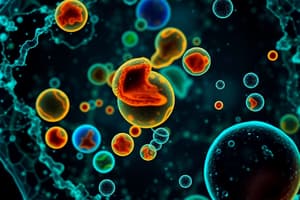Podcast
Questions and Answers
Which organelle is responsible for energy conversion into a usable form?
Which organelle is responsible for energy conversion into a usable form?
- Mitochondria (correct)
- Endoplasmic reticulum
- Lysosome
- Peroxisomes
What is the site of translation in the cell due to the presence of ribosomes?
What is the site of translation in the cell due to the presence of ribosomes?
- Rough endoplasmic reticulum (correct)
- Smooth endoplasmic reticulum
- Nucleus
- Golgi body
What is everything that is within the cell itself except for the nucleus?
What is everything that is within the cell itself except for the nucleus?
- Cytoplasm (correct)
- Lysosome
- Endoplasmic reticulum
- Golgi body
Which organelle is the site of protein folding, packaging of macromolecules into vesicles, and shipping of those vesicles throughout the cell?
Which organelle is the site of protein folding, packaging of macromolecules into vesicles, and shipping of those vesicles throughout the cell?
Which organelle contains the genetic information (DNA and RNA), as well as being the site of DNA replication and transcription?
Which organelle contains the genetic information (DNA and RNA), as well as being the site of DNA replication and transcription?
Which organelles are responsible for breaking down old cell structures, endocytosed material, and toxic materials inside the cell?
Which organelles are responsible for breaking down old cell structures, endocytosed material, and toxic materials inside the cell?
Who were the scientists involved in the discovery of the cytoplasm?
Who were the scientists involved in the discovery of the cytoplasm?
What are the primary roles of the cytoplasm?
What are the primary roles of the cytoplasm?
What provides support and structure to the cell, allowing it to maintain its shape?
What provides support and structure to the cell, allowing it to maintain its shape?
Where do many cellular metabolic processes, including glycolysis, occur?
Where do many cellular metabolic processes, including glycolysis, occur?
Flashcards are hidden until you start studying
Study Notes
The Cytoplasm: Structure, Function, and Discovery
- Lysosomes and peroxisomes are key organelles in the cell, responsible for breaking down old cell structures, endocytosed material, and toxic materials produced inside the cell.
- In addition to organelles, cells contain structures like ribosomes, vesicles, cytoskeleton, and cytosol, which collectively make up the cytoplasm.
- The cytoplasm was discovered in 1835 by George E. Palade, Albert Claude, and Christian de Duve, and the term was first used by Rudolph von Kolliker in 1863.
- The cytoplasm consists of cytosol, organelles, cytoskeleton, and cytoplasmic inclusions, working together to maintain cell function and autonomy.
- The gel-like nature of the cytoplasm allows for fluidity and structure, providing protection to organelles and enabling cellular processes.
- The cytoplasm has five primary roles: transport, maintenance of cell shape and structure, protection, storage, and metabolic processes.
- Transport within the cell is facilitated by vesicles and the cytoskeleton, allowing for efficient movement of molecules.
- The cytosol maintains cell volume, while the cytoskeleton provides support and structure, allowing the cell to maintain its shape.
- The gel-like nature of the cytoplasm protects organelles and genetic material from damage by absorbing shocks.
- The cytoplasm contains cytoplasmic inclusions and vesicles, serving as a storage site for extra materials and molecules.
- Many cellular metabolic processes, including glycolysis and catabolic and anabolic reactions, occur within the cytoplasm.
- The discovery of the cytoplasm and advancements in microscopy have significantly contributed to our understanding of cellular structures and functions.
Studying That Suits You
Use AI to generate personalized quizzes and flashcards to suit your learning preferences.





